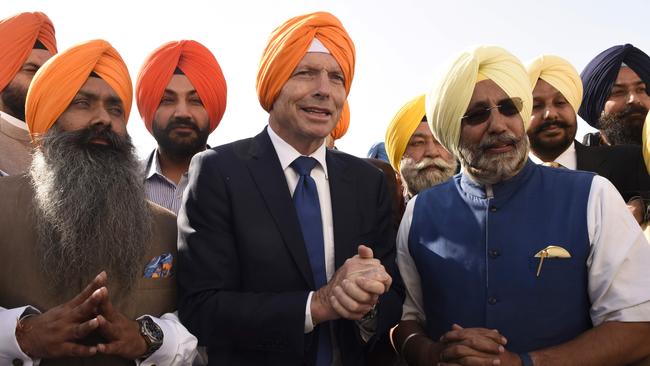
Perhaps this is why the relationship between Australia and India, until recently, has largely been taken for granted; while that with China has been carefully cultivated by all governments and assiduously fostered by all prime ministers since Bob Hawke (who at the time of his death had made more than 100 trips to China).
While still keeping up the China relationship, it was this relationship with India that my government was so determined to accelerate: through finalising the nuclear understanding to enable the export to India of Australian uranium; reviving the Quadrilateral Security Dialogue with the US, India, Japan and Australia that Kevin Rudd had scuttled; and efforts to secure a trade deal.
It’s a real pity there was no prime ministerial visit to India in 2015 that could have sealed the free trade agreement Prime Minister Narendra Modi and I had pledged to complete within a year, but perhaps this is something Modi and Scott Morrison may return to in their discussions in Delhi in February. It would be the most obvious way to demonstrate our countries’ commitment to each other. Even now, though, Australian officialdom seems unnecessarily cautious about the potential of the Australia-India relationship. The otherwise excellent official report on Australia’s economic strategy with India to 2035 goes out of its way to stress that India “is not the next China”.
A throwaway line, perhaps, but why not, given that in 40 years India’s GDP has more than quadrupled; it has been the world’s fastest growing big economy for the past five years; and more than 500 million Indians now have uncensored, unmonitored smartphones connecting them to the formal market economy?
If the 1.3 billion Indians in India could achieve like the one million Indians in Australia, India would amaze the world. I suppose the same might be said of the Chinese — except that the government of a one-party state would never let them.
We might be grateful that India will not be the next China politically. But why would anyone simply assume that India wouldn’t be the next China economically?
Why should Australian officials think that what one country of a billion people could achieve under the dictatorship of the proletariat was impossible in another that had the blessings of democracy, the rule of law and the English language? Unless, of course, they’re closet admirers of a command market economy, regard the Chinese as somehow superior to everyone else, or — most likely — don’t want to admit that Australia may have put too many eggs into the China basket.
In my time as prime minister, China formally upgraded its relationship with Australia to a “comprehensive strategic partnership”, one of 11. I was keen have the strongest possible links with China consistent with our values, and our military alliances revolving around the US. Hence, we finalised the most thoroughgoing trade deal that China had with anyone; and agreed to join the Chinese-led Asia Infrastructure Investment Bank once better governance rules had been put in place.
But we didn’t finalise the extradition treaty begun under the Howard government — how could we with a country where the courts were instruments of the ruling party? We flew military aircraft through China’s unilaterally declared air defence zone over disputed islands. And Australia started to lift military spending to 2 per cent of GDP and began a naval build-up in recognition of the darkening strategic dynamic in our region that only has worsened since.
The often glossed-over reality is that it’s hard for Australia to be a meaningful strategic partner to a country that thinks it can bully its neighbours on the basis of confected territorial claims that it refuses to submit to arbitration and tries to resolve unilaterally in its favour. It’s hard for any country to be other than a client, or a strategic competitor, with a country that still regards itself as the “Middle Kingdom” and that now has dropped the mask of hiding its strength and biding its time.
Especially if China dumps “one-country, two-systems” for Hong Kong and becomes more belligerent with Taiwan, but even if it just vigorously prosecutes its territorial claims against countries like India and Japan, it’s hard to see relations with China rising much above the level of a “cold peace”.
Of course, Australia should continue to offer China the food and resource security it craves and to share our thinking on what makes an economy more prosperous and a society more humane, because that’s in everyone’s interest. But we should be very cautious about the kind of one-sided technical engagement that leaves us relatively weaker and China relatively stronger.
Again, this is where India comes in. My instinct is that, 50 years hence, India will be much more prosperous and no less democratic; every bit as strong as China, in fact, but far less overbearing. I hope Australia will be a key partner in India’s rise. A world with two democratic superpowers, not just one, will be more free, open, prosperous and ultimately fairer to everyone — because that’s the way countries are (even superpowers) when they have to take all their citizens seriously.
Paul Keating is right in this respect. The industrial revolution decoupled GDP from population, but globalisation means that strength once more corresponds to size. There is only one solution to the problem of a world dominated by China, and that’s India.
Tony Abbott is our 28th prime minister. This is based on a speech this week to the India Foundation in Delhi.




A partnership between two democracies such as India and Australia should be far easier to build than one between Australia and a one-party communist state such as China.